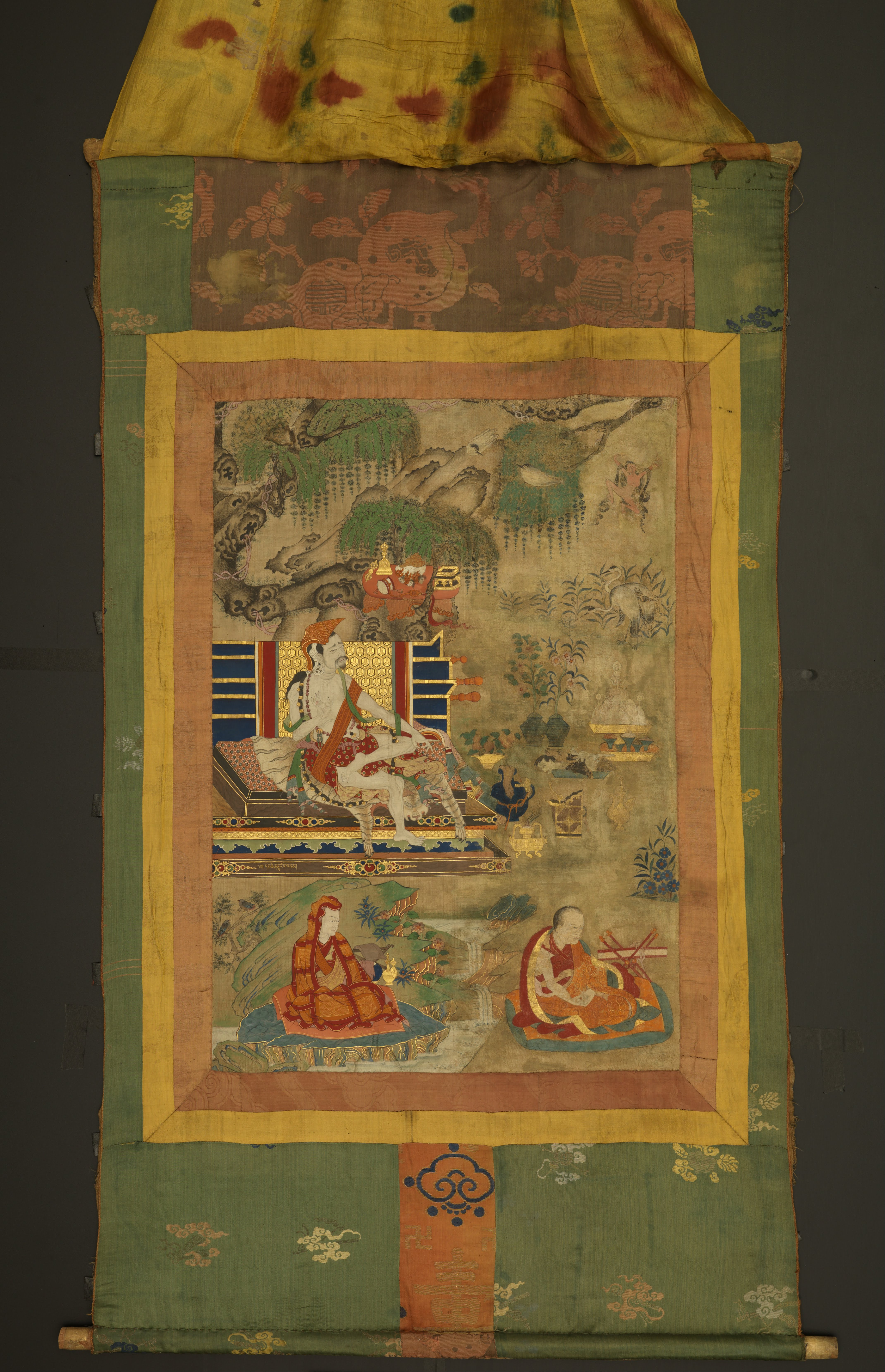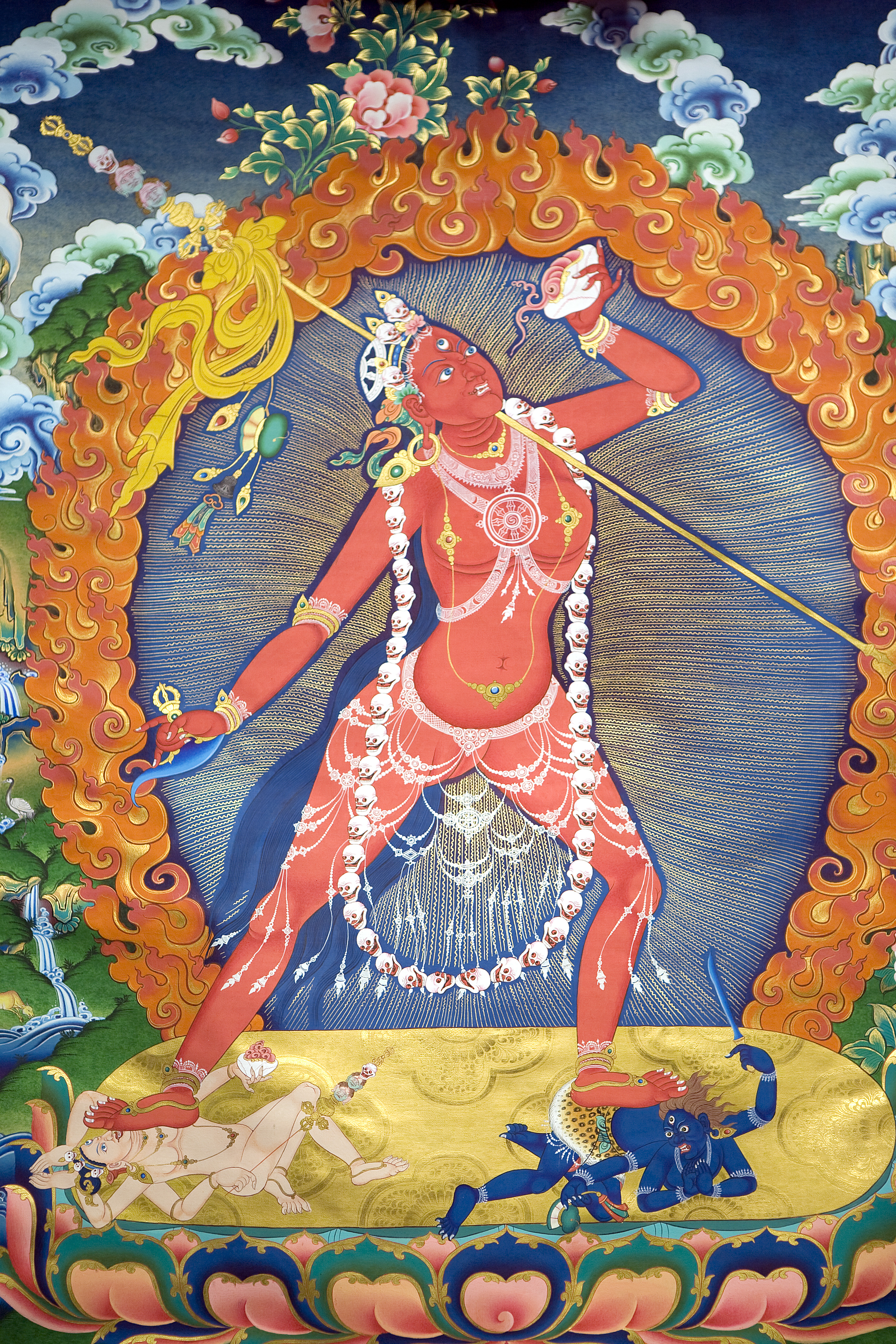|
Phowa
''Phowa'' (, ) is a tantric practice found in both Hinduism and Buddhism. It may be described as "transference of consciousness at the time of death", " mindstream transference", "the practice of conscious dying", or "enlightenment without meditation" (). In Tibetan Buddhism phowa is one of the Six yogas of Naropa and also appears in many other lineages and systems of teaching. Lama Thubten Yeshe taught on the subject of phowa that "We have to choose the right time to transfer our consciousness; we’re not allowed to do it at the wrong time because that becomes suicide." Outside of Buddhism "This controversial esoteric technique (Skt. utkrānti), by which a tantric practitioner is able to sever his connection to the physical body, goes by the Indian reference to 'yogic' or spiritual suicide. It is referred to in many Saiva scriptures, in one Vaisnava Samhita, and a handful of Sākta Tantras. Application The method can be applied at the moment of death to, according to V ... [...More Info...] [...Related Items...] OR: [Wikipedia] [Google] [Baidu] |
Tibetan Buddhism
Tibetan Buddhism is a form of Buddhism practiced in Tibet, Bhutan and Mongolia. It also has a sizable number of adherents in the areas surrounding the Himalayas, including the Indian regions of Ladakh, Gorkhaland Territorial Administration, Darjeeling, Sikkim, and Arunachal Pradesh, as well as in Nepal. Smaller groups of practitioners can be found in Central Asia, some regions of China such as Northeast China, Xinjiang, Inner Mongolia and some regions of Russia, such as Tuva, Buryatia, and Kalmykia. Tibetan Buddhism evolved as a form of Mahayana, Mahāyāna Buddhism stemming from the latest stages of Indian Buddhism (which included many Vajrayana, Vajrayāna elements). It thus preserves many Indian Buddhist Tantra, tantric practices of the Gupta Empire, post-Gupta Medieval India, early medieval period (500–1200 CE), along with numerous native Tibetan developments. In the pre-modern era, Tibetan Buddhism spread outside of Tibet primarily due to the influence of the Mongol Emp ... [...More Info...] [...Related Items...] OR: [Wikipedia] [Google] [Baidu] |
Six Yogas Of Naropa
The Six Dharmas of Nāropa (, Skt. ''ṣaḍdharma'', "Naro's six doctrines" or "six teachings") are a set of advanced Tibetan Buddhist tantric practices compiled by the Indian mahasiddhas Tilopa and Nāropa (1016–1100 CE) and passed on to the Tibetan translator-yogi Marpa Lotsawa (). Another name for the six Dharmas is "the oral instruction transmission for achieving liberation in the bardo," or "the ''Bardo Trang-dol'' system". Bardo here, refers to the three bardos of waking, sleep and dying. They are also referred to as "the path of means" (''thabs lam'') in Kagyu literature.Kragh (2015), p. 345. They are also sometimes called the ''Six Yogas of Nāropa'' (though not in the traditional literature which never uses the term ''ṣaḍaṅga-yoga'' or ''sbyor-drug''). The six dharmas are a collection of tantric Buddhist completion stage practices drawn from the Buddhist tantras. They are intended to lead to Buddhahood in an accelerated manner. They traditionally require ... [...More Info...] [...Related Items...] OR: [Wikipedia] [Google] [Baidu] |
Kagyu
The ''Kagyu'' school, also transliterated as ''Kagyü'', or ''Kagyud'' (), which translates to "Oral Lineage" or "Whispered Transmission" school, is one of the main schools (''chos lugs'') of Tibetan Buddhism, Tibetan (or Himalayan) Buddhism. The Kagyu lineages trace themselves back to the 11th century Indian Mahasiddhas Naropa, Maitripa and the yogini Niguma, via their student Marpa Lotsawa (1012–1097), who brought their teachings to Tibet. Marpa's student Milarepa was also an influential poet and teacher. The Tibetan Kagyu tradition gave rise to a large number of independent sub-schools and lineages. The principal Kagyu lineages existing today as independent schools are those which stem from Milarepa's disciple, Gampopa (1079–1153), a monk who merged the Kagyu lineage with the Kadam (Tibetan Buddhism), Kadam tradition. The Kagyu schools which survive as independent institutions are mainly the Karma Kagyu, Drikung Kagyu, Drukpa Lineage and the Taklung Kagyu. The Karma Kag ... [...More Info...] [...Related Items...] OR: [Wikipedia] [Google] [Baidu] |
Six Dharmas Of Naropa
The Six Dharmas of Nāropa (, Sanskrit, Skt. ''ṣaḍdharma'', "Naro's six doctrines" or "six teachings") are a set of advanced Vajrayana Yoga, Tibetan Buddhist tantric practices compiled by the Indian mahasiddhas Tilopa and Nāropa (1016–1100 CE) and passed on to the Tibetan translator-yogi Marpa Lotsawa (). Another name for the six Dharma (Buddhism), Dharmas is "the oral instruction transmission for achieving liberation in the bardo," or "the ''Bardo Trang-dol'' system". Bardo here, refers to the three bardos of waking, sleep and dying. They are also referred to as "the path of means" (''thabs lam'') in Kagyu literature.Kragh (2015), p. 345. They are also sometimes called the ''Six Yogas of Nāropa'' (though not in the traditional literature which never uses the term ''ṣaḍaṅga-yoga'' or ''sbyor-drug''). The six dharmas are a collection of tantric Buddhist Deity yoga, completion stage practices drawn from the Tantras (Buddhism), Buddhist tantras. They are intended to le ... [...More Info...] [...Related Items...] OR: [Wikipedia] [Google] [Baidu] |
Sanskrit
Sanskrit (; stem form ; nominal singular , ,) is a classical language belonging to the Indo-Aryan languages, Indo-Aryan branch of the Indo-European languages. It arose in northwest South Asia after its predecessor languages had Trans-cultural diffusion, diffused there from the northwest in the late Bronze Age#South Asia, Bronze Age. Sanskrit is the sacred language of Hinduism, the language of classical Hindu philosophy, and of historical texts of Buddhism and Jainism. It was a lingua franca, link language in ancient and medieval South Asia, and upon transmission of Hindu and Buddhist culture to Southeast Asia, East Asia and Central Asia in the early medieval era, it became a language of religion and high culture, and of the political elites in some of these regions. As a result, Sanskrit had a lasting effect on the languages of South Asia, Southeast Asia and East Asia, especially in their formal and learned vocabularies. Sanskrit generally connotes several Indo-Aryan languages# ... [...More Info...] [...Related Items...] OR: [Wikipedia] [Google] [Baidu] |
Sukhavati
Sukhavati ( IAST: ''Sukhāvatī''; "Blissful"; Chinese: 極樂世界, lit. "realm of ultimate bliss") is the pure land (or buddhafield) of the Buddha Amitābha in Mahayana Buddhism. Sukhavati is also called the Land of Bliss or Western Pure Land and is the most well-known of the Mahayana Buddhist pure lands due to the popularity of Pure Land Buddhism in East Asia. Sukhavati is also an important postmortem goal for Tibetan Buddhists, and is a common buddhafield used in the practice of phowa ("transference of consciousness at the time of death"). Sukhavati was widely depicted in Mahayana Buddhist art and remains an important theme in Buddhist art. Different traditions understand the nature of Sukhavati differently. The Pure Land Buddhist traditions often sees it as a Samboghakaya pure land (this was the view of Shandao), while other traditions, like some Tibetan Buddhists, see it as a nirmanakaya Pure Land. Furthermore, in Chinese Buddhism, there are two views on Sukhava ... [...More Info...] [...Related Items...] OR: [Wikipedia] [Google] [Baidu] |
Marpa Lotsawa
Marpa Lotsāwa (, 1012–1097), sometimes known fully as Marpa Chökyi Lodrö ( Wylie: mar pa chos kyi blo gros) or commonly as Marpa the Translator (Marpa Lotsāwa), was a Tibetan Buddhist teacher credited with the transmission of many Vajrayana teachings from India, including the teachings and lineages of Mahamudra. Due to this, the Kagyu lineage, which he founded, is often called Marpa Kagyu in his honour.samye.orgThe Kagyu Lineage: the Tibetan Lineage Masters: Marpa the Translator/ref> Although some accounts relate that the Mahasiddha Naropa was the personal teacher of Marpa, other accounts suggest that Marpa held Naropa's lineage through intermediary disciples only. Either way, Marpa was a personal student of the Mahasiddha Maitripa and of the dakini Niguma. Biography Born as Marpa Chökyi Lodrö, in Lhodrak Chukhyer in the southern part of Tibet, to an affluent family, he began studying at a young age but was wild and untamed compared to other children. Marpa first rece ... [...More Info...] [...Related Items...] OR: [Wikipedia] [Google] [Baidu] |
Tilopa
Tilopa (Prakrit; Sanskrit: Talika or Tilopadā; 988–1069) was an Indian Buddhist tantric mahasiddha who lived along the Ganges River. He practised Anuttarayoga Tantra, a set of spiritual practices intended to accelerate the process of attaining Buddhahood. He became a holder of all the tantric lineages, possibly the only person in his day to do so. In addition to the way of insight and Mahamudra, Tilopa learned and passed on the Way of Methods (today known as the Six Dharmas of Naropa, Six Yogas of Naropa) and guru yoga. Naropa is considered his main student. Life Tilopa was born into the priestly Brahmin caste of Bengalis, Bengali origin in Eastern India. He adopted the monastery, monastic life upon receiving orders from a dakini (female buddha whose activity is to inspire practitioners) who told him to adopt a mendicant and itinerant minister, itinerant existence. From the beginning, she made it clear to Tilopa that his real parents were not the persons who had raised him bu ... [...More Info...] [...Related Items...] OR: [Wikipedia] [Google] [Baidu] |
Naropa
Nāropā (Prakrit; , Naḍapāda or Abhayakirti) was an Indian Buddhism, Buddhist Mahasiddha. He was the disciple of Tilopa and brother, or some sources say partner and pupil, of Niguma. As an Indian Mahasiddha, Naropa's instructions inform Vajrayana, particularly his six yogas of Naropa relevant to the completion stage of anuttarayogatantra. He was also one of the "gatekeepers" of Vikramashila monastery which is located in Bihar. Although some accounts relate that Naropa was the personal teacher of Marpa Lotsawa, other accounts suggest that Marpa held Naropa's lineage through intermediary disciples only. Names According to scholar John Newman, "the Tibetans give Nāro's name as ''Nā ro pa, Nā ro paṇ chen, Nā ro ta pa,'' and so forth. The manuscript of the ''Paramarthasaṃgraha'' preserves a Sanskrit form ''Naḍapāda'' (''Paramarthasaṃgraha'' 74). A Sanskrit manuscript edited by Tucci preserves an apparent Prakrit form ''Nāropā'', as well as a semi-Sanskritic '' ... [...More Info...] [...Related Items...] OR: [Wikipedia] [Google] [Baidu] |
Chöd
Chöd ( lit. 'to sever') is a spiritual practice found primarily in the Yundrung Bön tradition as well as in the Nyingma and Kagyu schools of Tibetan Buddhism (where it is classed as Anuttarayoga Tantra in Kagyu and Anuyoga in Nyingma). Also known as "cutting through the ego," the practices are based on the Prajñāpāramitā or "Perfection of Wisdom" sutras, which expound the "emptiness" concept of Buddhist philosophy. According to Mahayana Buddhists, emptiness is the ultimate wisdom of understanding that all things lack inherent existence. Chöd combines prajñāpāramitā philosophy with specific meditation methods and tantric ritual. The chod practitioner seeks to tap the power of fear through activities such as rituals set in graveyards, and visualisation of offering their bodies in a tantric feast in order to put their understanding of emptiness to the ultimate test. Definition and Sanskrit ''chedasādhanā'' both literally mean "cutting practice". In Standard Tibet ... [...More Info...] [...Related Items...] OR: [Wikipedia] [Google] [Baidu] |
Hannah Nydahl
Hannah Nydahl (1946–2007), wife of Lama Ole Nydahl, was a Danish teacher and translator in the Karma Kagyu lineage of Tibetan Buddhism.Nydahl, Ole (1992) ''Riding The Tiger, Twenty Years on the Road - The Risks and Joys of Bringing Tibetan Buddhism to the West'', Blue Dolphin Publishing. Early life She was born and died in Copenhagen, Denmark. Hannah and her husband Ole Nydahl, who assisted her work, were childhood friends, meeting for the first time when Hannah was 5 and Ole 10.Nydahl, Ole "Entering The Diamond Way, Tibetan Buddhism Meets the West", Blue Dolphin Publishing (1999). Involvement with Buddhism Under the spiritual direction of The 16th Gyalwa Karmapa, Rangjung Rigpe Dorje Hannah Nydahl and Ole Nydahl Founded Diamond Way Buddhism, a Buddhist organization for lay practitioners within the Karma Kagyu school of Tibetan Buddhism. Hannah and Ole Nydahl were introduced to Buddhism on their honeymoon in Nepal in 1968, and were among the first Westerners to become s ... [...More Info...] [...Related Items...] OR: [Wikipedia] [Google] [Baidu] |









